BA230 - Advanced Management Accounting: Overhead Cost Analysis
VerifiedAdded on 2023/06/11
|8
|2942
|96
Report
AI Summary
This report analyzes various cost methods, focusing on overhead allocation within a manufacturing context. It compares traditional costing methods with Activity-Based Costing (ABC), assessing the benefits and drawbacks of each. The report explores how Valdosta Vinyl Company (VVC) can improve its product costing system by revising its overhead application, specifically within the cutting and finishing departments, and by accommodating automation in the moulding department. Recommendations include outsourcing, waste reduction, and strategic automation to enhance efficiency and cost-effectiveness. The report concludes that while ABC offers more accurate costing, its implementation costs may be significant, requiring careful consideration of the trade-offs between accuracy and expense.
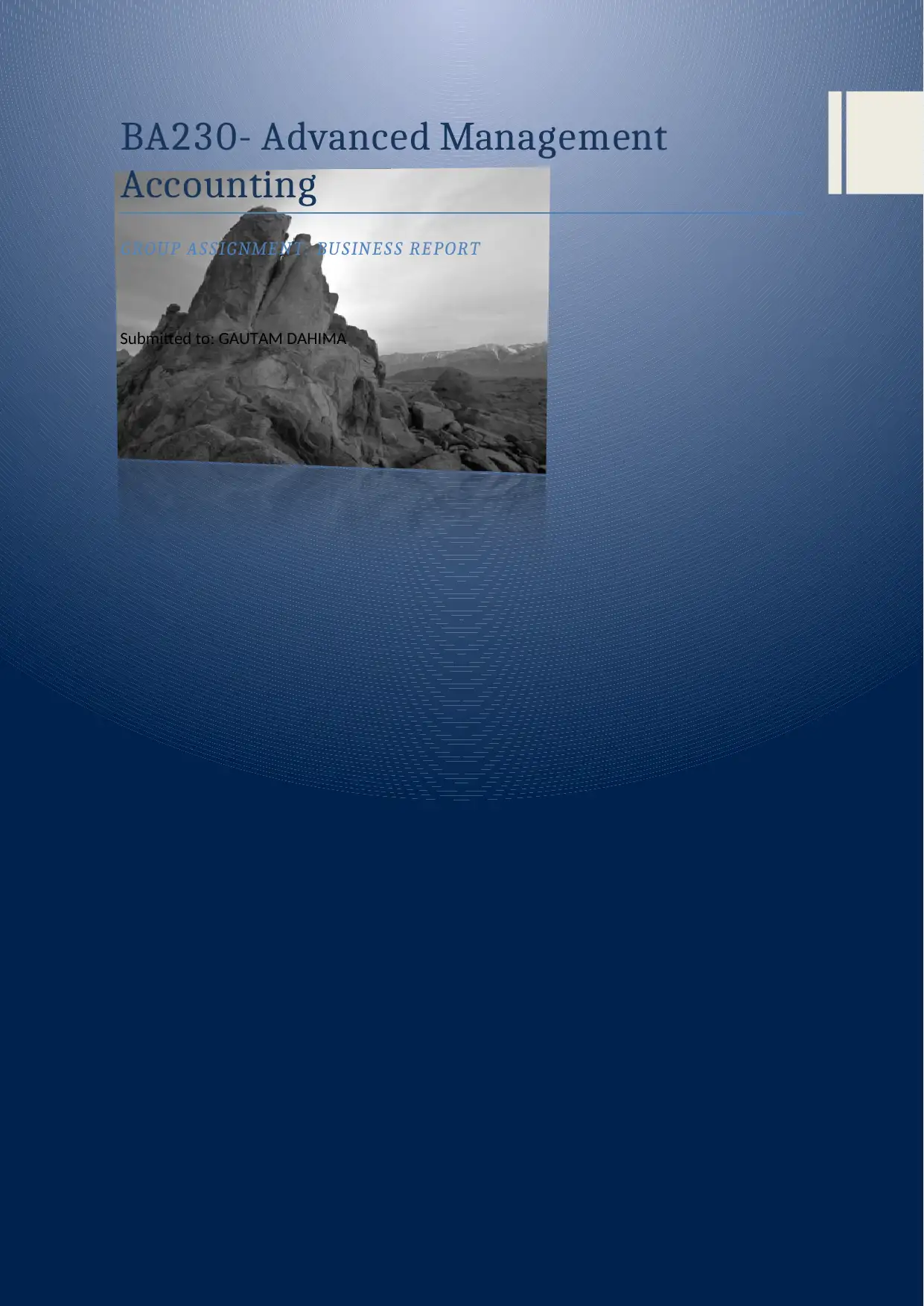
BA230- Advanced Management
Accounting
GROUP ASSIGNMENT: BUSINESS REPORT
Submitted to: GAUTAM DAHIMA
Accounting
GROUP ASSIGNMENT: BUSINESS REPORT
Submitted to: GAUTAM DAHIMA
Paraphrase This Document
Need a fresh take? Get an instant paraphrase of this document with our AI Paraphraser
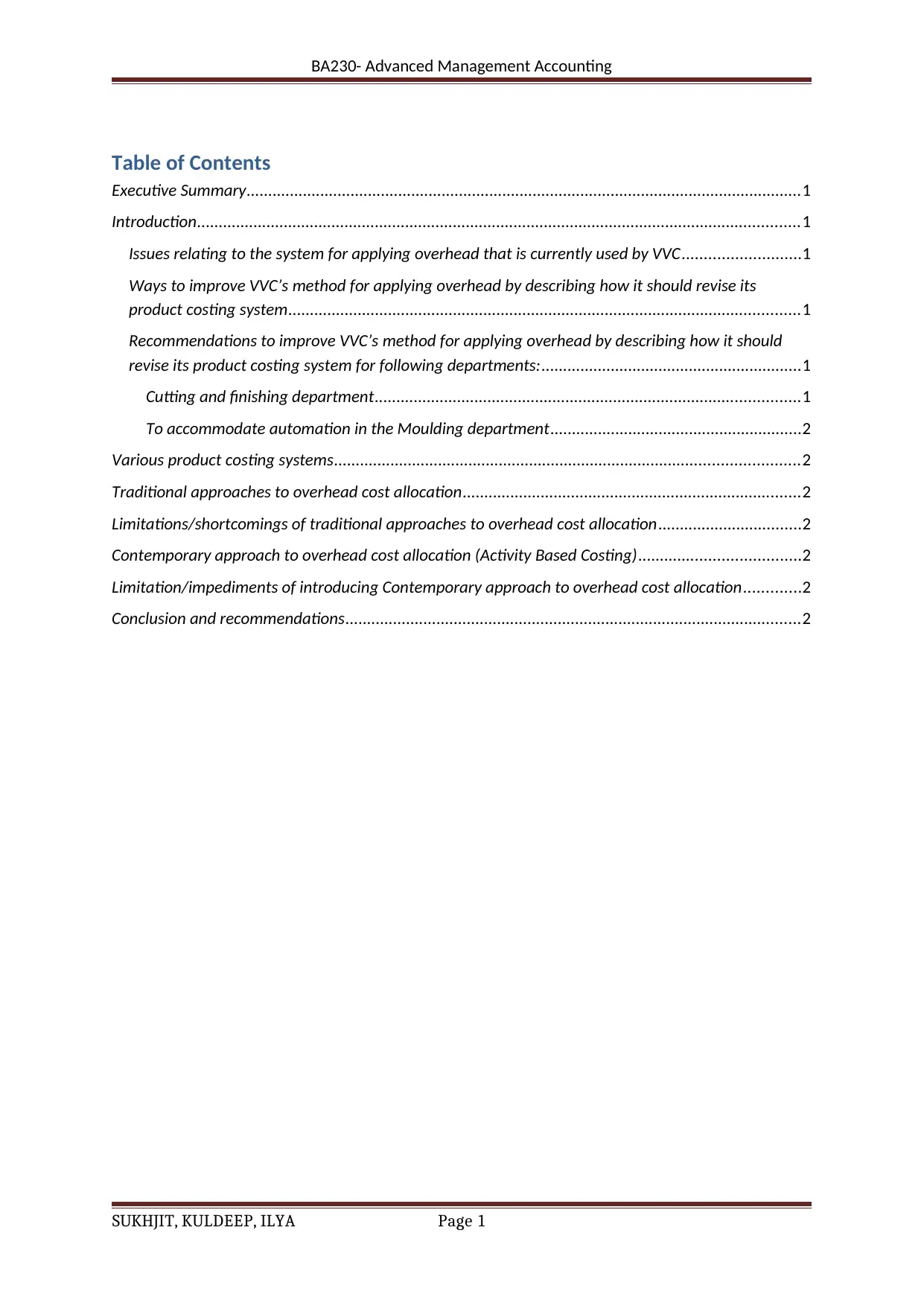
BA230- Advanced Management Accounting
Table of Contents
Executive Summary................................................................................................................................1
Introduction...........................................................................................................................................1
Issues relating to the system for applying overhead that is currently used by VVC...........................1
Ways to improve VVC’s method for applying overhead by describing how it should revise its
product costing system......................................................................................................................1
Recommendations to improve VVC’s method for applying overhead by describing how it should
revise its product costing system for following departments:............................................................1
Cutting and finishing department..................................................................................................1
To accommodate automation in the Moulding department..........................................................2
Various product costing systems...........................................................................................................2
Traditional approaches to overhead cost allocation..............................................................................2
Limitations/shortcomings of traditional approaches to overhead cost allocation.................................2
Contemporary approach to overhead cost allocation (Activity Based Costing).....................................2
Limitation/impediments of introducing Contemporary approach to overhead cost allocation.............2
Conclusion and recommendations.........................................................................................................2
SUKHJIT, KULDEEP, ILYA Page 1
Table of Contents
Executive Summary................................................................................................................................1
Introduction...........................................................................................................................................1
Issues relating to the system for applying overhead that is currently used by VVC...........................1
Ways to improve VVC’s method for applying overhead by describing how it should revise its
product costing system......................................................................................................................1
Recommendations to improve VVC’s method for applying overhead by describing how it should
revise its product costing system for following departments:............................................................1
Cutting and finishing department..................................................................................................1
To accommodate automation in the Moulding department..........................................................2
Various product costing systems...........................................................................................................2
Traditional approaches to overhead cost allocation..............................................................................2
Limitations/shortcomings of traditional approaches to overhead cost allocation.................................2
Contemporary approach to overhead cost allocation (Activity Based Costing).....................................2
Limitation/impediments of introducing Contemporary approach to overhead cost allocation.............2
Conclusion and recommendations.........................................................................................................2
SUKHJIT, KULDEEP, ILYA Page 1
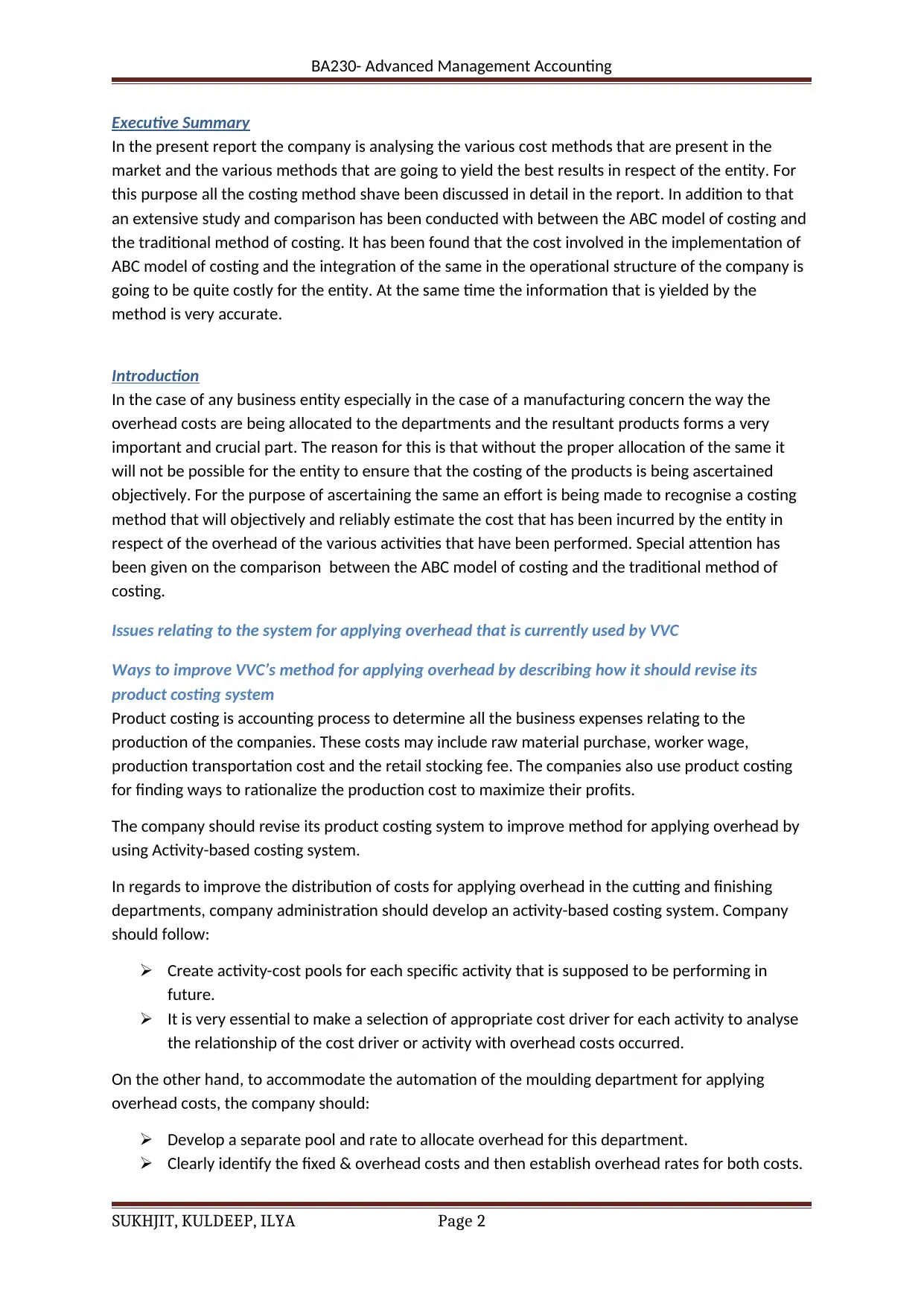
BA230- Advanced Management Accounting
Executive Summary
In the present report the company is analysing the various cost methods that are present in the
market and the various methods that are going to yield the best results in respect of the entity. For
this purpose all the costing method shave been discussed in detail in the report. In addition to that
an extensive study and comparison has been conducted with between the ABC model of costing and
the traditional method of costing. It has been found that the cost involved in the implementation of
ABC model of costing and the integration of the same in the operational structure of the company is
going to be quite costly for the entity. At the same time the information that is yielded by the
method is very accurate.
Introduction
In the case of any business entity especially in the case of a manufacturing concern the way the
overhead costs are being allocated to the departments and the resultant products forms a very
important and crucial part. The reason for this is that without the proper allocation of the same it
will not be possible for the entity to ensure that the costing of the products is being ascertained
objectively. For the purpose of ascertaining the same an effort is being made to recognise a costing
method that will objectively and reliably estimate the cost that has been incurred by the entity in
respect of the overhead of the various activities that have been performed. Special attention has
been given on the comparison between the ABC model of costing and the traditional method of
costing.
Issues relating to the system for applying overhead that is currently used by VVC
Ways to improve VVC’s method for applying overhead by describing how it should revise its
product costing system
Product costing is accounting process to determine all the business expenses relating to the
production of the companies. These costs may include raw material purchase, worker wage,
production transportation cost and the retail stocking fee. The companies also use product costing
for finding ways to rationalize the production cost to maximize their profits.
The company should revise its product costing system to improve method for applying overhead by
using Activity-based costing system.
In regards to improve the distribution of costs for applying overhead in the cutting and finishing
departments, company administration should develop an activity-based costing system. Company
should follow:
Create activity-cost pools for each specific activity that is supposed to be performing in
future.
It is very essential to make a selection of appropriate cost driver for each activity to analyse
the relationship of the cost driver or activity with overhead costs occurred.
On the other hand, to accommodate the automation of the moulding department for applying
overhead costs, the company should:
Develop a separate pool and rate to allocate overhead for this department.
Clearly identify the fixed & overhead costs and then establish overhead rates for both costs.
SUKHJIT, KULDEEP, ILYA Page 2
Executive Summary
In the present report the company is analysing the various cost methods that are present in the
market and the various methods that are going to yield the best results in respect of the entity. For
this purpose all the costing method shave been discussed in detail in the report. In addition to that
an extensive study and comparison has been conducted with between the ABC model of costing and
the traditional method of costing. It has been found that the cost involved in the implementation of
ABC model of costing and the integration of the same in the operational structure of the company is
going to be quite costly for the entity. At the same time the information that is yielded by the
method is very accurate.
Introduction
In the case of any business entity especially in the case of a manufacturing concern the way the
overhead costs are being allocated to the departments and the resultant products forms a very
important and crucial part. The reason for this is that without the proper allocation of the same it
will not be possible for the entity to ensure that the costing of the products is being ascertained
objectively. For the purpose of ascertaining the same an effort is being made to recognise a costing
method that will objectively and reliably estimate the cost that has been incurred by the entity in
respect of the overhead of the various activities that have been performed. Special attention has
been given on the comparison between the ABC model of costing and the traditional method of
costing.
Issues relating to the system for applying overhead that is currently used by VVC
Ways to improve VVC’s method for applying overhead by describing how it should revise its
product costing system
Product costing is accounting process to determine all the business expenses relating to the
production of the companies. These costs may include raw material purchase, worker wage,
production transportation cost and the retail stocking fee. The companies also use product costing
for finding ways to rationalize the production cost to maximize their profits.
The company should revise its product costing system to improve method for applying overhead by
using Activity-based costing system.
In regards to improve the distribution of costs for applying overhead in the cutting and finishing
departments, company administration should develop an activity-based costing system. Company
should follow:
Create activity-cost pools for each specific activity that is supposed to be performing in
future.
It is very essential to make a selection of appropriate cost driver for each activity to analyse
the relationship of the cost driver or activity with overhead costs occurred.
On the other hand, to accommodate the automation of the moulding department for applying
overhead costs, the company should:
Develop a separate pool and rate to allocate overhead for this department.
Clearly identify the fixed & overhead costs and then establish overhead rates for both costs.
SUKHJIT, KULDEEP, ILYA Page 2
⊘ This is a preview!⊘
Do you want full access?
Subscribe today to unlock all pages.

Trusted by 1+ million students worldwide
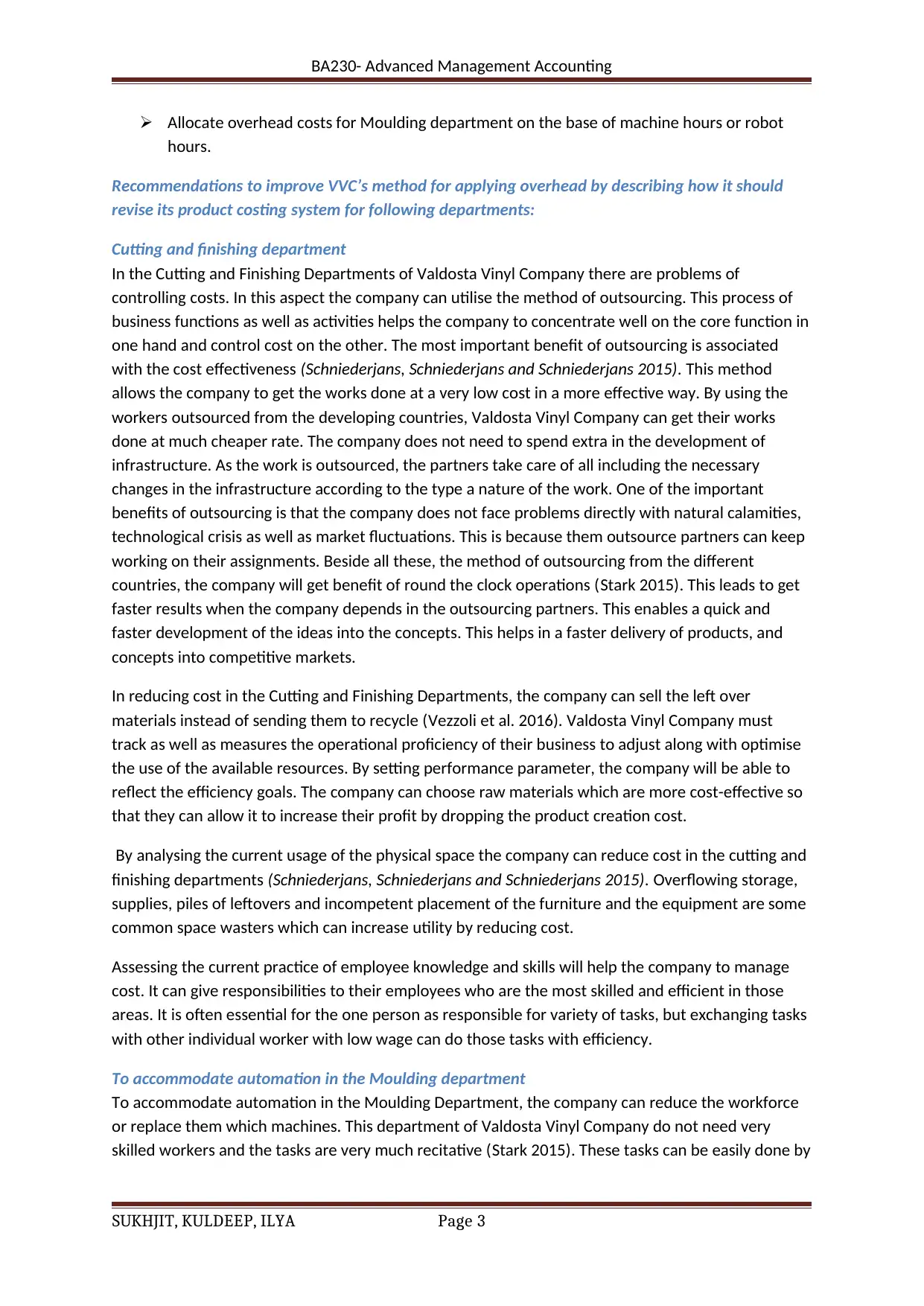
BA230- Advanced Management Accounting
Allocate overhead costs for Moulding department on the base of machine hours or robot
hours.
Recommendations to improve VVC’s method for applying overhead by describing how it should
revise its product costing system for following departments:
Cutting and finishing department
In the Cutting and Finishing Departments of Valdosta Vinyl Company there are problems of
controlling costs. In this aspect the company can utilise the method of outsourcing. This process of
business functions as well as activities helps the company to concentrate well on the core function in
one hand and control cost on the other. The most important benefit of outsourcing is associated
with the cost effectiveness (Schniederjans, Schniederjans and Schniederjans 2015). This method
allows the company to get the works done at a very low cost in a more effective way. By using the
workers outsourced from the developing countries, Valdosta Vinyl Company can get their works
done at much cheaper rate. The company does not need to spend extra in the development of
infrastructure. As the work is outsourced, the partners take care of all including the necessary
changes in the infrastructure according to the type a nature of the work. One of the important
benefits of outsourcing is that the company does not face problems directly with natural calamities,
technological crisis as well as market fluctuations. This is because them outsource partners can keep
working on their assignments. Beside all these, the method of outsourcing from the different
countries, the company will get benefit of round the clock operations (Stark 2015). This leads to get
faster results when the company depends in the outsourcing partners. This enables a quick and
faster development of the ideas into the concepts. This helps in a faster delivery of products, and
concepts into competitive markets.
In reducing cost in the Cutting and Finishing Departments, the company can sell the left over
materials instead of sending them to recycle (Vezzoli et al. 2016). Valdosta Vinyl Company must
track as well as measures the operational proficiency of their business to adjust along with optimise
the use of the available resources. By setting performance parameter, the company will be able to
reflect the efficiency goals. The company can choose raw materials which are more cost-effective so
that they can allow it to increase their profit by dropping the product creation cost.
By analysing the current usage of the physical space the company can reduce cost in the cutting and
finishing departments (Schniederjans, Schniederjans and Schniederjans 2015). Overflowing storage,
supplies, piles of leftovers and incompetent placement of the furniture and the equipment are some
common space wasters which can increase utility by reducing cost.
Assessing the current practice of employee knowledge and skills will help the company to manage
cost. It can give responsibilities to their employees who are the most skilled and efficient in those
areas. It is often essential for the one person as responsible for variety of tasks, but exchanging tasks
with other individual worker with low wage can do those tasks with efficiency.
To accommodate automation in the Moulding department
To accommodate automation in the Moulding Department, the company can reduce the workforce
or replace them which machines. This department of Valdosta Vinyl Company do not need very
skilled workers and the tasks are very much recitative (Stark 2015). These tasks can be easily done by
SUKHJIT, KULDEEP, ILYA Page 3
Allocate overhead costs for Moulding department on the base of machine hours or robot
hours.
Recommendations to improve VVC’s method for applying overhead by describing how it should
revise its product costing system for following departments:
Cutting and finishing department
In the Cutting and Finishing Departments of Valdosta Vinyl Company there are problems of
controlling costs. In this aspect the company can utilise the method of outsourcing. This process of
business functions as well as activities helps the company to concentrate well on the core function in
one hand and control cost on the other. The most important benefit of outsourcing is associated
with the cost effectiveness (Schniederjans, Schniederjans and Schniederjans 2015). This method
allows the company to get the works done at a very low cost in a more effective way. By using the
workers outsourced from the developing countries, Valdosta Vinyl Company can get their works
done at much cheaper rate. The company does not need to spend extra in the development of
infrastructure. As the work is outsourced, the partners take care of all including the necessary
changes in the infrastructure according to the type a nature of the work. One of the important
benefits of outsourcing is that the company does not face problems directly with natural calamities,
technological crisis as well as market fluctuations. This is because them outsource partners can keep
working on their assignments. Beside all these, the method of outsourcing from the different
countries, the company will get benefit of round the clock operations (Stark 2015). This leads to get
faster results when the company depends in the outsourcing partners. This enables a quick and
faster development of the ideas into the concepts. This helps in a faster delivery of products, and
concepts into competitive markets.
In reducing cost in the Cutting and Finishing Departments, the company can sell the left over
materials instead of sending them to recycle (Vezzoli et al. 2016). Valdosta Vinyl Company must
track as well as measures the operational proficiency of their business to adjust along with optimise
the use of the available resources. By setting performance parameter, the company will be able to
reflect the efficiency goals. The company can choose raw materials which are more cost-effective so
that they can allow it to increase their profit by dropping the product creation cost.
By analysing the current usage of the physical space the company can reduce cost in the cutting and
finishing departments (Schniederjans, Schniederjans and Schniederjans 2015). Overflowing storage,
supplies, piles of leftovers and incompetent placement of the furniture and the equipment are some
common space wasters which can increase utility by reducing cost.
Assessing the current practice of employee knowledge and skills will help the company to manage
cost. It can give responsibilities to their employees who are the most skilled and efficient in those
areas. It is often essential for the one person as responsible for variety of tasks, but exchanging tasks
with other individual worker with low wage can do those tasks with efficiency.
To accommodate automation in the Moulding department
To accommodate automation in the Moulding Department, the company can reduce the workforce
or replace them which machines. This department of Valdosta Vinyl Company do not need very
skilled workers and the tasks are very much recitative (Stark 2015). These tasks can be easily done by
SUKHJIT, KULDEEP, ILYA Page 3
Paraphrase This Document
Need a fresh take? Get an instant paraphrase of this document with our AI Paraphraser
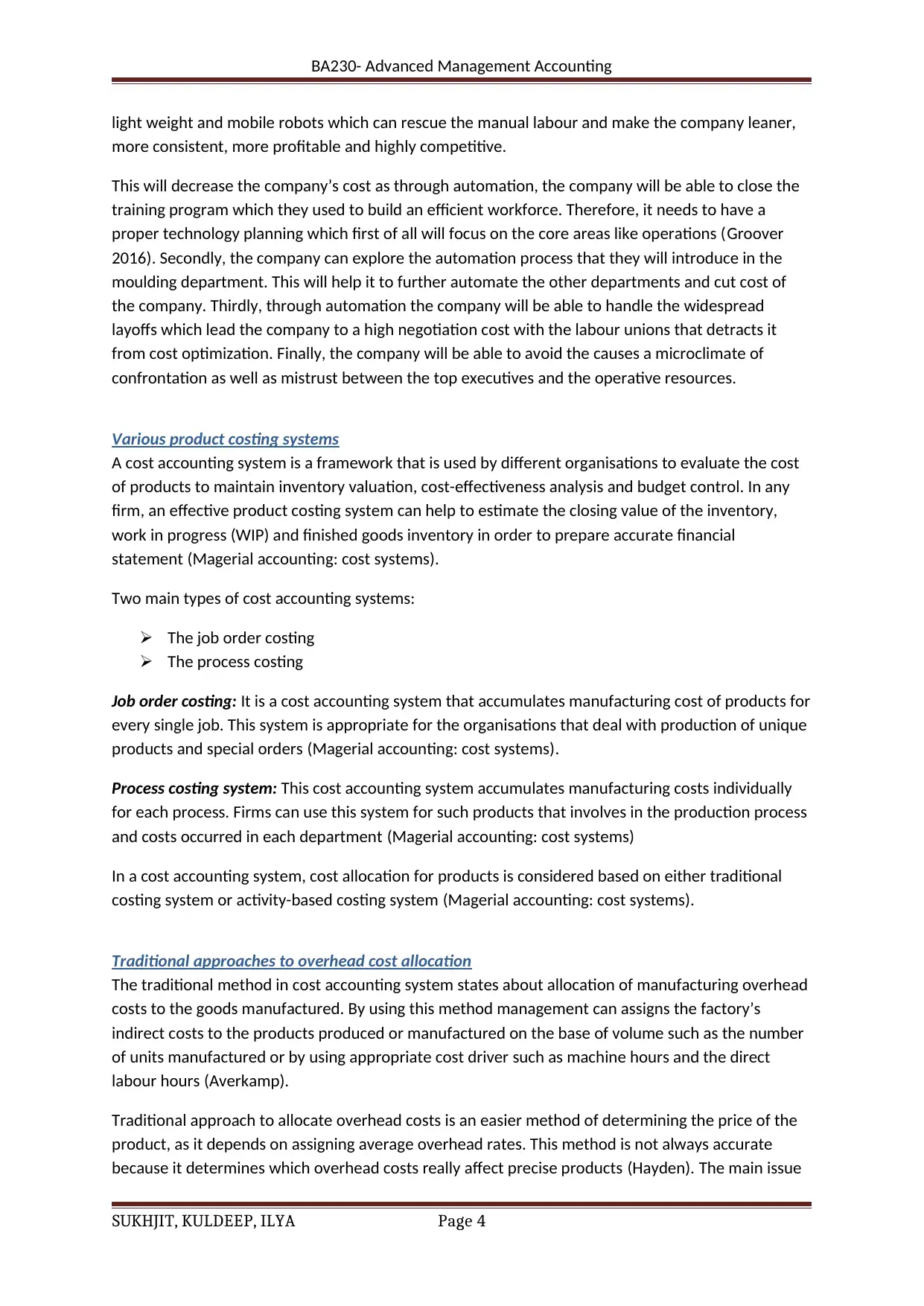
BA230- Advanced Management Accounting
light weight and mobile robots which can rescue the manual labour and make the company leaner,
more consistent, more profitable and highly competitive.
This will decrease the company’s cost as through automation, the company will be able to close the
training program which they used to build an efficient workforce. Therefore, it needs to have a
proper technology planning which first of all will focus on the core areas like operations (Groover
2016). Secondly, the company can explore the automation process that they will introduce in the
moulding department. This will help it to further automate the other departments and cut cost of
the company. Thirdly, through automation the company will be able to handle the widespread
layoffs which lead the company to a high negotiation cost with the labour unions that detracts it
from cost optimization. Finally, the company will be able to avoid the causes a microclimate of
confrontation as well as mistrust between the top executives and the operative resources.
Various product costing systems
A cost accounting system is a framework that is used by different organisations to evaluate the cost
of products to maintain inventory valuation, cost-effectiveness analysis and budget control. In any
firm, an effective product costing system can help to estimate the closing value of the inventory,
work in progress (WIP) and finished goods inventory in order to prepare accurate financial
statement (Magerial accounting: cost systems).
Two main types of cost accounting systems:
The job order costing
The process costing
Job order costing: It is a cost accounting system that accumulates manufacturing cost of products for
every single job. This system is appropriate for the organisations that deal with production of unique
products and special orders (Magerial accounting: cost systems).
Process costing system: This cost accounting system accumulates manufacturing costs individually
for each process. Firms can use this system for such products that involves in the production process
and costs occurred in each department (Magerial accounting: cost systems)
In a cost accounting system, cost allocation for products is considered based on either traditional
costing system or activity-based costing system (Magerial accounting: cost systems).
Traditional approaches to overhead cost allocation
The traditional method in cost accounting system states about allocation of manufacturing overhead
costs to the goods manufactured. By using this method management can assigns the factory’s
indirect costs to the products produced or manufactured on the base of volume such as the number
of units manufactured or by using appropriate cost driver such as machine hours and the direct
labour hours (Averkamp).
Traditional approach to allocate overhead costs is an easier method of determining the price of the
product, as it depends on assigning average overhead rates. This method is not always accurate
because it determines which overhead costs really affect precise products (Hayden). The main issue
SUKHJIT, KULDEEP, ILYA Page 4
light weight and mobile robots which can rescue the manual labour and make the company leaner,
more consistent, more profitable and highly competitive.
This will decrease the company’s cost as through automation, the company will be able to close the
training program which they used to build an efficient workforce. Therefore, it needs to have a
proper technology planning which first of all will focus on the core areas like operations (Groover
2016). Secondly, the company can explore the automation process that they will introduce in the
moulding department. This will help it to further automate the other departments and cut cost of
the company. Thirdly, through automation the company will be able to handle the widespread
layoffs which lead the company to a high negotiation cost with the labour unions that detracts it
from cost optimization. Finally, the company will be able to avoid the causes a microclimate of
confrontation as well as mistrust between the top executives and the operative resources.
Various product costing systems
A cost accounting system is a framework that is used by different organisations to evaluate the cost
of products to maintain inventory valuation, cost-effectiveness analysis and budget control. In any
firm, an effective product costing system can help to estimate the closing value of the inventory,
work in progress (WIP) and finished goods inventory in order to prepare accurate financial
statement (Magerial accounting: cost systems).
Two main types of cost accounting systems:
The job order costing
The process costing
Job order costing: It is a cost accounting system that accumulates manufacturing cost of products for
every single job. This system is appropriate for the organisations that deal with production of unique
products and special orders (Magerial accounting: cost systems).
Process costing system: This cost accounting system accumulates manufacturing costs individually
for each process. Firms can use this system for such products that involves in the production process
and costs occurred in each department (Magerial accounting: cost systems)
In a cost accounting system, cost allocation for products is considered based on either traditional
costing system or activity-based costing system (Magerial accounting: cost systems).
Traditional approaches to overhead cost allocation
The traditional method in cost accounting system states about allocation of manufacturing overhead
costs to the goods manufactured. By using this method management can assigns the factory’s
indirect costs to the products produced or manufactured on the base of volume such as the number
of units manufactured or by using appropriate cost driver such as machine hours and the direct
labour hours (Averkamp).
Traditional approach to allocate overhead costs is an easier method of determining the price of the
product, as it depends on assigning average overhead rates. This method is not always accurate
because it determines which overhead costs really affect precise products (Hayden). The main issue
SUKHJIT, KULDEEP, ILYA Page 4
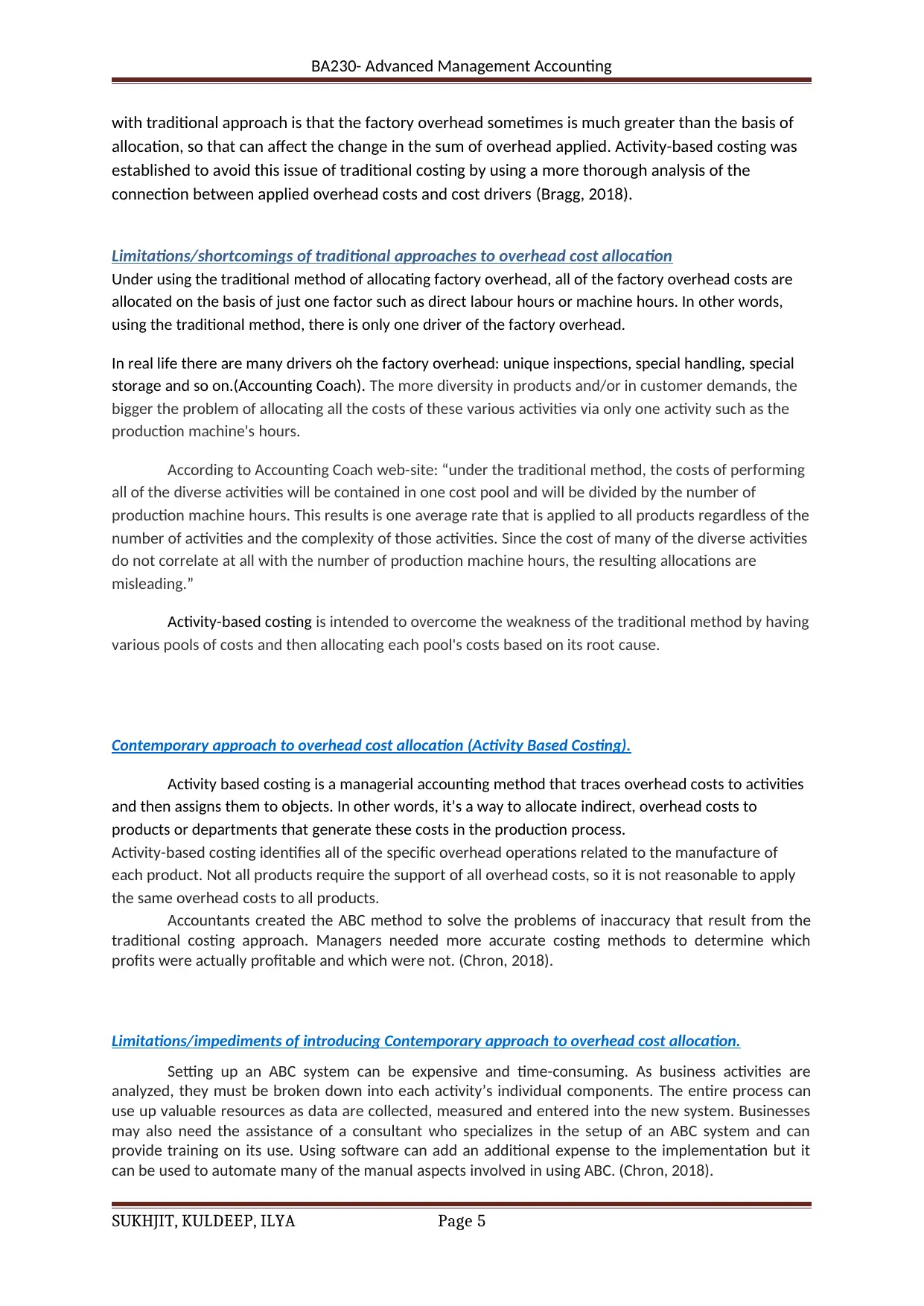
BA230- Advanced Management Accounting
with traditional approach is that the factory overhead sometimes is much greater than the basis of
allocation, so that can affect the change in the sum of overhead applied. Activity-based costing was
established to avoid this issue of traditional costing by using a more thorough analysis of the
connection between applied overhead costs and cost drivers (Bragg, 2018).
Limitations/shortcomings of traditional approaches to overhead cost allocation
Under using the traditional method of allocating factory overhead, all of the factory overhead costs are
allocated on the basis of just one factor such as direct labour hours or machine hours. In other words,
using the traditional method, there is only one driver of the factory overhead.
In real life there are many drivers oh the factory overhead: unique inspections, special handling, special
storage and so on.(Accounting Coach). The more diversity in products and/or in customer demands, the
bigger the problem of allocating all the costs of these various activities via only one activity such as the
production machine's hours.
According to Accounting Coach web-site: “under the traditional method, the costs of performing
all of the diverse activities will be contained in one cost pool and will be divided by the number of
production machine hours. This results is one average rate that is applied to all products regardless of the
number of activities and the complexity of those activities. Since the cost of many of the diverse activities
do not correlate at all with the number of production machine hours, the resulting allocations are
misleading.”
Activity-based costing is intended to overcome the weakness of the traditional method by having
various pools of costs and then allocating each pool's costs based on its root cause.
Contemporary approach to overhead cost allocation (Activity Based Costing).
Activity based costing is a managerial accounting method that traces overhead costs to activities
and then assigns them to objects. In other words, it’s a way to allocate indirect, overhead costs to
products or departments that generate these costs in the production process.
Activity-based costing identifies all of the specific overhead operations related to the manufacture of
each product. Not all products require the support of all overhead costs, so it is not reasonable to apply
the same overhead costs to all products.
Accountants created the ABC method to solve the problems of inaccuracy that result from the
traditional costing approach. Managers needed more accurate costing methods to determine which
profits were actually profitable and which were not. (Chron, 2018).
Limitations/impediments of introducing Contemporary approach to overhead cost allocation.
Setting up an ABC system can be expensive and time-consuming. As business activities are
analyzed, they must be broken down into each activity’s individual components. The entire process can
use up valuable resources as data are collected, measured and entered into the new system. Businesses
may also need the assistance of a consultant who specializes in the setup of an ABC system and can
provide training on its use. Using software can add an additional expense to the implementation but it
can be used to automate many of the manual aspects involved in using ABC. (Chron, 2018).
SUKHJIT, KULDEEP, ILYA Page 5
with traditional approach is that the factory overhead sometimes is much greater than the basis of
allocation, so that can affect the change in the sum of overhead applied. Activity-based costing was
established to avoid this issue of traditional costing by using a more thorough analysis of the
connection between applied overhead costs and cost drivers (Bragg, 2018).
Limitations/shortcomings of traditional approaches to overhead cost allocation
Under using the traditional method of allocating factory overhead, all of the factory overhead costs are
allocated on the basis of just one factor such as direct labour hours or machine hours. In other words,
using the traditional method, there is only one driver of the factory overhead.
In real life there are many drivers oh the factory overhead: unique inspections, special handling, special
storage and so on.(Accounting Coach). The more diversity in products and/or in customer demands, the
bigger the problem of allocating all the costs of these various activities via only one activity such as the
production machine's hours.
According to Accounting Coach web-site: “under the traditional method, the costs of performing
all of the diverse activities will be contained in one cost pool and will be divided by the number of
production machine hours. This results is one average rate that is applied to all products regardless of the
number of activities and the complexity of those activities. Since the cost of many of the diverse activities
do not correlate at all with the number of production machine hours, the resulting allocations are
misleading.”
Activity-based costing is intended to overcome the weakness of the traditional method by having
various pools of costs and then allocating each pool's costs based on its root cause.
Contemporary approach to overhead cost allocation (Activity Based Costing).
Activity based costing is a managerial accounting method that traces overhead costs to activities
and then assigns them to objects. In other words, it’s a way to allocate indirect, overhead costs to
products or departments that generate these costs in the production process.
Activity-based costing identifies all of the specific overhead operations related to the manufacture of
each product. Not all products require the support of all overhead costs, so it is not reasonable to apply
the same overhead costs to all products.
Accountants created the ABC method to solve the problems of inaccuracy that result from the
traditional costing approach. Managers needed more accurate costing methods to determine which
profits were actually profitable and which were not. (Chron, 2018).
Limitations/impediments of introducing Contemporary approach to overhead cost allocation.
Setting up an ABC system can be expensive and time-consuming. As business activities are
analyzed, they must be broken down into each activity’s individual components. The entire process can
use up valuable resources as data are collected, measured and entered into the new system. Businesses
may also need the assistance of a consultant who specializes in the setup of an ABC system and can
provide training on its use. Using software can add an additional expense to the implementation but it
can be used to automate many of the manual aspects involved in using ABC. (Chron, 2018).
SUKHJIT, KULDEEP, ILYA Page 5
⊘ This is a preview!⊘
Do you want full access?
Subscribe today to unlock all pages.

Trusted by 1+ million students worldwide
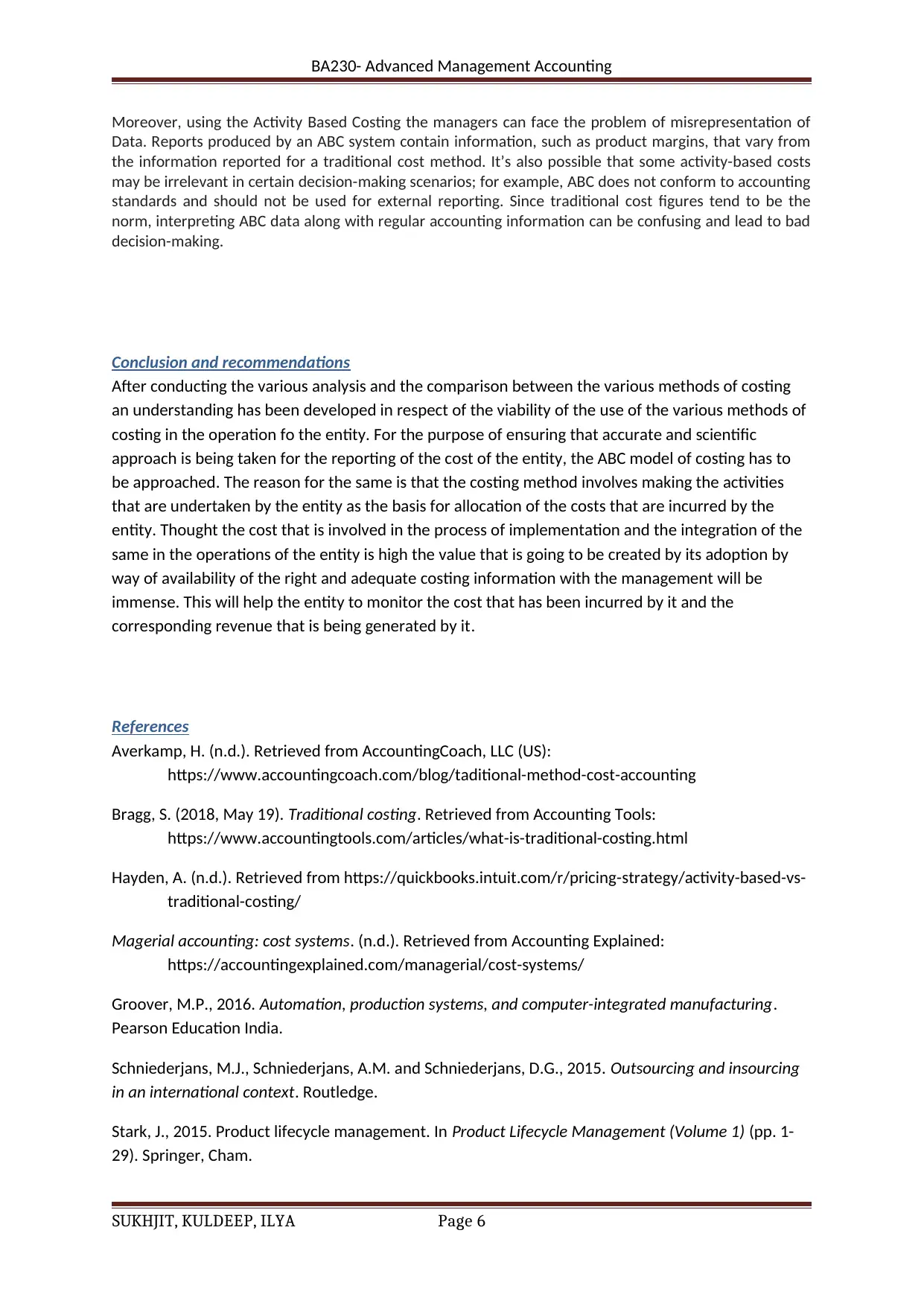
BA230- Advanced Management Accounting
Moreover, using the Activity Based Costing the managers can face the problem of misrepresentation of
Data. Reports produced by an ABC system contain information, such as product margins, that vary from
the information reported for a traditional cost method. It’s also possible that some activity-based costs
may be irrelevant in certain decision-making scenarios; for example, ABC does not conform to accounting
standards and should not be used for external reporting. Since traditional cost figures tend to be the
norm, interpreting ABC data along with regular accounting information can be confusing and lead to bad
decision-making.
Conclusion and recommendations
After conducting the various analysis and the comparison between the various methods of costing
an understanding has been developed in respect of the viability of the use of the various methods of
costing in the operation fo the entity. For the purpose of ensuring that accurate and scientific
approach is being taken for the reporting of the cost of the entity, the ABC model of costing has to
be approached. The reason for the same is that the costing method involves making the activities
that are undertaken by the entity as the basis for allocation of the costs that are incurred by the
entity. Thought the cost that is involved in the process of implementation and the integration of the
same in the operations of the entity is high the value that is going to be created by its adoption by
way of availability of the right and adequate costing information with the management will be
immense. This will help the entity to monitor the cost that has been incurred by it and the
corresponding revenue that is being generated by it.
References
Averkamp, H. (n.d.). Retrieved from AccountingCoach, LLC (US):
https://www.accountingcoach.com/blog/taditional-method-cost-accounting
Bragg, S. (2018, May 19). Traditional costing. Retrieved from Accounting Tools:
https://www.accountingtools.com/articles/what-is-traditional-costing.html
Hayden, A. (n.d.). Retrieved from https://quickbooks.intuit.com/r/pricing-strategy/activity-based-vs-
traditional-costing/
Magerial accounting: cost systems. (n.d.). Retrieved from Accounting Explained:
https://accountingexplained.com/managerial/cost-systems/
Groover, M.P., 2016. Automation, production systems, and computer-integrated manufacturing.
Pearson Education India.
Schniederjans, M.J., Schniederjans, A.M. and Schniederjans, D.G., 2015. Outsourcing and insourcing
in an international context. Routledge.
Stark, J., 2015. Product lifecycle management. In Product Lifecycle Management (Volume 1) (pp. 1-
29). Springer, Cham.
SUKHJIT, KULDEEP, ILYA Page 6
Moreover, using the Activity Based Costing the managers can face the problem of misrepresentation of
Data. Reports produced by an ABC system contain information, such as product margins, that vary from
the information reported for a traditional cost method. It’s also possible that some activity-based costs
may be irrelevant in certain decision-making scenarios; for example, ABC does not conform to accounting
standards and should not be used for external reporting. Since traditional cost figures tend to be the
norm, interpreting ABC data along with regular accounting information can be confusing and lead to bad
decision-making.
Conclusion and recommendations
After conducting the various analysis and the comparison between the various methods of costing
an understanding has been developed in respect of the viability of the use of the various methods of
costing in the operation fo the entity. For the purpose of ensuring that accurate and scientific
approach is being taken for the reporting of the cost of the entity, the ABC model of costing has to
be approached. The reason for the same is that the costing method involves making the activities
that are undertaken by the entity as the basis for allocation of the costs that are incurred by the
entity. Thought the cost that is involved in the process of implementation and the integration of the
same in the operations of the entity is high the value that is going to be created by its adoption by
way of availability of the right and adequate costing information with the management will be
immense. This will help the entity to monitor the cost that has been incurred by it and the
corresponding revenue that is being generated by it.
References
Averkamp, H. (n.d.). Retrieved from AccountingCoach, LLC (US):
https://www.accountingcoach.com/blog/taditional-method-cost-accounting
Bragg, S. (2018, May 19). Traditional costing. Retrieved from Accounting Tools:
https://www.accountingtools.com/articles/what-is-traditional-costing.html
Hayden, A. (n.d.). Retrieved from https://quickbooks.intuit.com/r/pricing-strategy/activity-based-vs-
traditional-costing/
Magerial accounting: cost systems. (n.d.). Retrieved from Accounting Explained:
https://accountingexplained.com/managerial/cost-systems/
Groover, M.P., 2016. Automation, production systems, and computer-integrated manufacturing.
Pearson Education India.
Schniederjans, M.J., Schniederjans, A.M. and Schniederjans, D.G., 2015. Outsourcing and insourcing
in an international context. Routledge.
Stark, J., 2015. Product lifecycle management. In Product Lifecycle Management (Volume 1) (pp. 1-
29). Springer, Cham.
SUKHJIT, KULDEEP, ILYA Page 6
Paraphrase This Document
Need a fresh take? Get an instant paraphrase of this document with our AI Paraphraser
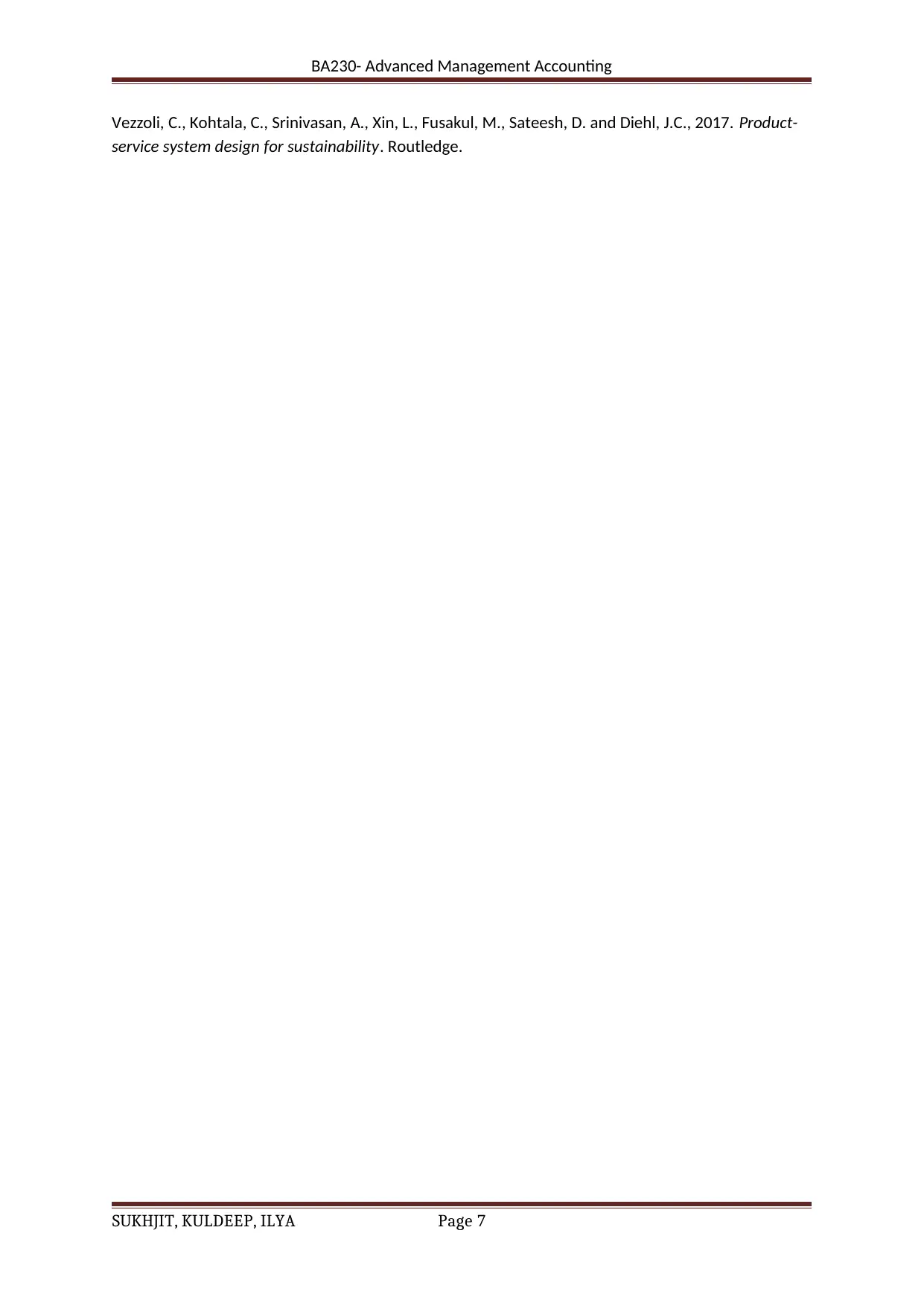
BA230- Advanced Management Accounting
Vezzoli, C., Kohtala, C., Srinivasan, A., Xin, L., Fusakul, M., Sateesh, D. and Diehl, J.C., 2017. Product-
service system design for sustainability. Routledge.
SUKHJIT, KULDEEP, ILYA Page 7
Vezzoli, C., Kohtala, C., Srinivasan, A., Xin, L., Fusakul, M., Sateesh, D. and Diehl, J.C., 2017. Product-
service system design for sustainability. Routledge.
SUKHJIT, KULDEEP, ILYA Page 7
1 out of 8
Related Documents
Your All-in-One AI-Powered Toolkit for Academic Success.
+13062052269
info@desklib.com
Available 24*7 on WhatsApp / Email
![[object Object]](/_next/static/media/star-bottom.7253800d.svg)
Unlock your academic potential
Copyright © 2020–2025 A2Z Services. All Rights Reserved. Developed and managed by ZUCOL.





